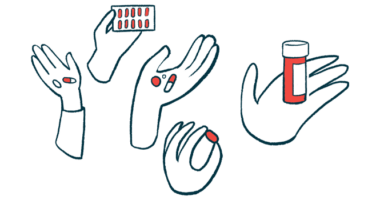Trikafta Improves Lung Function, Eases Inflammation in CF: Study
The therapy also reduced bacteria levels, partially restored systemic cytokine production

Trikafta (elexacaftor/tezacaftor/ivacaftor) improved lung function and reduced inflammation throughout the body over six months in patients with cystic fibrosis (CF), a new study reports.
Treatment with the triple-combination therapy also reduced detection of Pseudomonas aeruginosa and methicillin-resistant Staphylococcus aureus, or MRSA, two harmful bacteria that can cause lung infections in CF.
The study, “Impact of Elexacaftor-Tezacaftor-Ivacaftor on Bacterial Colonization and Inflammatory Responses in Cystic Fibrosis,” was published in Pediatric Pulmonology.
CF is caused by mutations in the CFTR gene that lead to the impaired regulation of the flow of salt and water in cells. This results in thick mucus building up in several organs, including the lungs, intestines, and liver.
Trikafta, developed by Vertex Pharmaceuticals, is approved in the U.S. to treat CF patients, ages 6 and older, with least one F508del mutation — the most common CF-causing mutation — in the CFTR gene or a CFTR mutation that responds to Trikafta in laboratory studies.
Although researchers know inflammation in CF damages the lungs, the association between abnormal CFTR function and inflammation is still unclear and it’s yet to be determined if increasing CFTR function with Trikafta eases inflammation.
Scientists at Nationwide Children’s Hospital, Ohio evaluated its effects on several clinical parameters, bacterial colonization by P. aeruginosa and MRSA, and indicators of inflammation.
Lung function was assessed by measuring forced expiratory volume in one second (FEV1), a measure of how much air someone can forcibly exhale, at the start of treatment and in three-month intervals for a year. The team also assessed body mass index (BMI, a measure of body fat) and sweat chloride — an indicator of CFTR function — and performed a bacterial analysis.
A total of 48 CF patients were included. The mean age was 28.8 and 58.3% were male. About 21 had the F508del mutation in the two CFTR copies and another 21 had only one mutation copy. A group of 20 healthy adults were included (mean age, 33.9) as controls.
Mean percent predicted FEV1 increased from 63% at the start of treatment to 71% after three months. After a year it was still significantly higher than at baseline (68%). Mean BMI also improved from 22.5 kg per square meter (kg/m2) at baseline to 23.5 kg/m2 at three months. By the one-year mark, it was at 24 kg/m2. Also, mean sweat chloride decreased significantly from 97.4 to 48.1 mEq/L after a month.
Bacteria were cultured from sputum samples and cytokines — signaling molecules that control immune cell activity — were measured in blood samples.
Twenty-five patients were positive for P. aeruginosa compared to 15 patients at three months after treatment. After a year, 10 had positive cultures. Likewise, 21 patients had positive MRSA cultures at the study’s start, 15 at three months, and 11 after a year.
Following six months of Trikafta, the levels of pro-inflammatory cytokines IL-8, IL-6, and IL-17A decreased significantly. All three cytokines were elevated at baseline relative to controls.
“Collectively, these data show that [Trikafta] improves clinical outcomes, bacterial detection in respiratory cultures, and systemic inflammation,” the researchers wrote.
Further blood tests of immune cells showed that after three months, neutrophils decreased significantly, whereas eosinophils and a subset of T-cells increased after treatment.
“In conclusion, in [people with CF, Trikafta] significantly improved FEV1 and BMI, decreased sweat chloride, was associated with a decrease in detection of Pseudomonas and MRSA in respiratory cultures, and partially restored systemic cytokine production and circulating immune cell composition,” the researchers wrote, noting long-term studies are needed to see if the impact of CFTR modulators such as Trikafta on inflammation is sustained.








